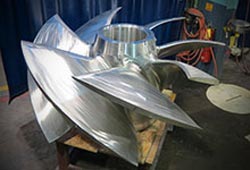New Waterjets Could Propel LCS to Greater Speeds

<br>
The product of an Office of Naval Research (ONR) Future Naval Capabilities (FNC) program, the waterjets arrived last month at the Marinette Marine shipyard in Wisconsin, where Milwaukee (LCS 5) is under construction.
“We believe these waterjets are the future,” said Dr. Ki-Han Kim, program manager in ONR’s Ship Systems and Engineering Research Division. “Anything that we can do to keep ships ready to go will ultimately benefit our warfighters.”
Chief of Naval Operations Adm. Jonathan Greenert’s 2013-2017 Navigation Plan calls for fielding improved ships to support counterterrorism and irregular warfare missions at sea and ashore. The LCS will play a big role in the Navy’s plan as a modular, adaptable vessel for use against diesel submarines, littoral mines and attacks by small surface craft.
Developed by Rolls-Royce Naval Marine in Walpole, Mass., in collaboration with ONR and Naval Surface Warfare Center, Carderock Division, the new Axial-Flow Waterjet Mk-1 can move nearly half a million gallons of seawater per minute, providing more thrust per unit than current commercial waterjets. Four of the new waterjets will propel the LCS to speeds greater than 40 knots.
Researchers believe the smaller, more efficient waterjets will help the LCS avoid excessive maintenance costs associated with cavitation — a phenomenon that occurs when changes in pressure create air bubbles on rotating machinery, such as marine propellers. Repeated occurrences can cause whole chunks of metal to wear away, leading to frequent repairs and replacements.
The waterjets’ new design could increase their lifespan between repairs.
The FNC program that oversaw development of this technology proved to be as adaptable as LCS. The waterjets originally were slated to benefit another ship program that was discontinued. Instead of cancelling the waterjets program, officials regrouped and shifted their focus to designing a product that would improve the performance of LCS.
ONR’s FNC program saves taxpayer money by streamlining processes to deliver cutting-edge products within five years. The waterjets project began in 2007, and the delivery last month to the shipyard marked its successful completion.
Next up for the waterjets will be full-scale sea trials on Milwaukee (LCS 5), expected to occur in the next 24 months.
Eventually, the waterjets could end up on 10 LCS under contract to be built by Lockheed Martin.
About the Office of Naval Research
The Department of the Navy’s Office of Naval Research (ONR) provides the science and technology necessary to maintain the Navy and Marine Corps’ technological advantage. Through its affiliates, ONR is a leader in science and technology with engagement in 50 states, 70 countries, 1,035 institutions of higher learning and 914 industry partners. ONR employs approximately 1,400 people, comprising uniformed, civilian and contract personnel, with additional employees at the Naval Research Lab in Washington, D.C.
Office of Naval Research
Corporate Strategic Communications
875 N. Randolph St., #1225-D
Arlington, Va., 22203-1771
Office: (703) 696-5031
Fax: (703) 696-5940
E-mail: onrcsc@onr.navy.mil
Web: www.onr.navy.mil
Facebook: www.facebook.com/officeofnavalresearch
Media Contact
More Information:
http://www.onr.navy.milAll latest news from the category: Machine Engineering
Machine engineering is one of Germany’s key industries. The importance of this segment has led to the creation of new university degree programs in fields such as production and logistics, process engineering, vehicle/automotive engineering, production engineering and aerospace engineering among others.
innovations-report offers informative reports and articles covering technologies such as automation, motion, power train, energy, conveyor, plastics, lightweight construction, logistics/warehousing, measurement systems, machine tools and control engineering.
Newest articles

NTU and NUS spin-off cutting-edge quantum control technology
AQSolotl’s quantum controller is designed to be adaptable, scalable and cost-efficient. Quantum technology jointly developed at Nanyang Technological University, Singapore (NTU Singapore) and National University of Singapore (NUS) has now…

How Geothermal Energy Shapes Bavaria’s Green Future Through Sustainable Energy
The Bavarian State Ministry of Science and the Arts has extended its funding for the research association “Geothermal Alliance Bavaria,” with the University of Bayreuth (UBT) continuing as a member…

Spintronics memory innovation: A new perpendicular magnetized film
Long gone are the days where all our data could fit on a two-megabyte floppy disk. In today’s information-based society, the increasing volume of information being handled demands that we…



